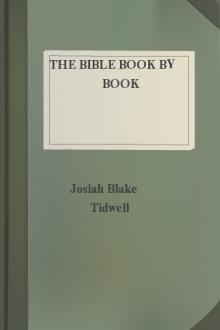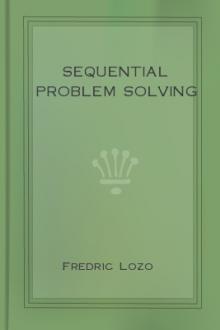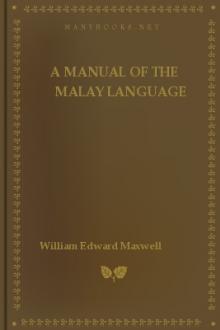The Bible Book by Book by Josiah Blake Tidwell (best short books to read .txt) 📕

- Author: Josiah Blake Tidwell
- Performer: -
Book online «The Bible Book by Book by Josiah Blake Tidwell (best short books to read .txt) 📕». Author Josiah Blake Tidwell
Other Books. Three other books should be read in connection with this study. (1) The book of Esther, which relates to this time and should be read between chapters 6 and 7 of the book of Ezra. (2) The books of Haggai and Zechariah. These two prophets were associated with the first return of Zerubbabel and their words incited the Jews to complete the temple in spite of opposition.
The Return from Captivity. The return consisted of three expeditions led respectively by Zerubbabel. Ezra and Nehemiah. The time covered can not be accurately calculated. It is probably not fewer than ninety years. Some think it may have been as many as one hundred and ten years.
Analysis of Ezra.
I. The Rebuilding of the Temple, Chs. 1-6.
1. The proclamation of Cyrus, 1.
2. Those who returned, 2.
3. The foundation laid, 3.
4. The work hindered, 4.
5. The work finished, 5-6.
II. The Reforms of Ezra, Chs. 7-10.
1. Ezra's Journey, 7-8.
2. The confession of sin, 9.
3. The covenant to keep the law. 10.
For Study and Discussion. (1) The traits of character displayed by Ezra. (2) The reforms of Ezra. (a) What were they? (b) Parallel conditions of today. (3) The adversaries of Judah. (a) Who were they? (b) The nature of their opposition. (4) The decree of Cyrus. (5) The expedition of Zerubbabel and Ezra. (6) Ezra's commission and the king's orders 7:1-26. (7) God's use of friends and enemies in forwarding his purposes.
Analysis of Nehemiah.
I. The Rebuilding of the Wall, Chs. 1-7.
1. Nehemiah permitted to go to Jerusalem, 1-2.
2. The work on the walls and its hindrance, 3-7.
II. The Covenant to Keep the Law, Chs. 8-10.
1. The law read, 8.
2. Confession made, 9.
3. The covenant made, 10.
III. The Walls Dedicated and Nehemiah's Reform, Chs. 11-13.
1. Those who dwelt in the city, 11:1-12:26.
2. The walls dedicated, 12:27-47 end.
3. Evils corrected, Ch. 13.
For Study and Discussion. (1) Point out elements of strength in the character and work of Nehemiah. (2) The greatness and difficulty of Nehemiah's task, (a) the rubbish, (b) the size and length of the wall, (c) the strength of their enemies. (3) The reforms of Nehemiah, (a) religious, (b) moral, (c) political. (4) The public meeting and new festival, 8:1-18. (5) The covenant 9:1-10:39. (6) The repeopling of Jerusalem, Chs. 11-12.
Esther.
Name. This is taken from its principal character, a Jewish maiden became queen of a Persian King.
Purpose. To explain the origin of the feast of Purim work of providence for God's people.
Time. The events narrated are thought to have occurred about 56 years after the first return of Zerubbabel in 536 B. C. The King then would be Xerxes the Great, and the drunken feast may have been preparatory to the invasion of Greece in the third year of his reign. Connection with Other Books. There is no connection between Esther and the other books of the Bible. While it is a story of the time when the Jews were returning to Jerusalem, and very likely should come between the first and second return, and, therefore, between the sixth and seventh chapters of Ezra, the incident stands alone. Without it we would lose much of our knowledge of that period.
The Story. While Esther stands out as the principal character, the whole story turns on the refusal of Mordecai to bow down to Haman, which would have been to show him divine honor. He did not hate Haman but, as a Jew could not worship any other than God. He dared to stand for principle at the risk of his life.
The Name of God. One of the peculiarities of the book is that it nowhere mentions the name of God, or makes any reference to him. This may be because his name was held secret and sacred at that time. However, God's power and His care of His people are everywhere implied in the book.
Analysis.
I. Esther Made Queen, Chs. 1-2.
1. Queen Vashti dethroned. Ch. 1.
2. Esther made queen. Ch. 2.
II. Haman's Plot and its Defeat. Chs. 3-8.
1. Haman plots the destruction of the Jews. Ch. 3.
2. The Jews' mourning and Mordecai's plea to Esther. Ch. 4.
3. Esther banquets Haman and the King, Ch. 5.
4. Mordecai highly honored for former service. Ch. 6.
5. Esther's plea granted and Haman hanged, Ch. 7,
6. The Jews allowed defense and Mordecai advanced, Ch. 8.
III. The Jews' Deliverance, Chs. 9-10.
1. Their enemies slain, 9:1-16.
2. A memorial feast is established. 9:17-32 end.
3. Mordecai made great, Ch. 10.
For Study and Discussion. (1) The character of the king, Vashti, Mordecai, Esther and Haman. (2) Mordecai's plea to Esther. (3) The honor of Mordecai and humiliation of Haman, Ch. 6. (4) The destruction of their enemies. (5) The feast of Purim, 9:17-32. (6) Truth about God seen in this book. (7) Why not name the book Mordecai or Vashti-are they not as heroic as Esther? (8) The race devotion of the Jews, then and now. (9) Persian life as seen in the book.
Job.
Name. Job, from its chief character, or hero, and mean "Persecuted."
Date. Neither the date nor the author can be determined with certainty. I incline to the theory of the Job authorship.
Connection with Other Books. It stands alone, being one of the so- called wisdom books of the Bible. It nowhere alludes to the Mosaic law or the history of Israel.
Literary Characteristics. Chapters one and two and parts of chapter forty-two are prose. All the rest is poetry. The different speakers may have been real speakers, or characters created by one writer to make the story. There is, however, little doubt that the story is founded on historical facts.
The Problems of the Book. This book raises several great questions, that are common to the race, and directly or indirectly discusses them. Among those questions the following are the most important. (1) Is there any goodness without reward? "Doth Job serve God or naught"? (2) Why do the righteous suffer and why does sin go unpunished? (3) Does God really care for and protect his people who fear him? (4) Is adversity and affliction a sign that the sufferer is wicked? (5) Is God a God of pity and mercy!
The Argument. The argument proceeds as follows: (1) There is a conference between God and Satan and the consequent affliction of Job. (2) The first cycle of discussion with his three friends in which they charge Job with sin and he denies the charge. (3) The second cycle of discussion. In this Job's friends argue that his claim of innocence is a further evidence of his guilt and impending danger. (4) The third cycle. In this cycle Job's friends argue that his afflictions are just the kind that would come to one who yielded to temptations such as those to which he is subject. In each of the three cycles of discussion with his friends, Eliphaz, Bildad and Zophar, each argues with Job except that Zophar remains silent in the third cycle. They speak in the same order each time. (5) Elihu shows how Job accuses God wrongly while vindicating himself and asserts that suffering instructs us in righteousness and prevents us from sinning. (6) God intervenes and in two addresses instructs Job. In the first address, Job is shown the creative power of the Almighty and his own folly in answering God whom animals by instinct fear. In the second address, Job is shown that one should know how to rule the world and correct its evils before one complains at or accuses God. (7) Job prays and is restored.
Purpose. The purpose of the book, then, is to justify the wisdom and goodness of God in matters of human suffering and especially to show that all suffering is not punitive.
Job's temptation. Job's temptation came by stages and consisted largely in a series of losses as follows: (1) His property, (2) His children, (3) His health, (4) His wife's confidence-she would have him curse God and die. (5) His friends who now think him a sinner, (6) The joy of life-he cursed the day of his birth, (7) His confidence in the goodness of God-he said to God, "Why hast thou set me as a mark for thee?" In his reply to Elihu he doubts the justice if not the very existence of God.
Analysis.
I. Job's Wealth and Affliction. Chs. 1-2.
II. The Discussion of Job and His Three Friends. Cha. 3-31.
1. The first cycle, 3-14.
2. The second cycle, Chs. 15-21.
3. The third cycle, Chs. 22-31.
III. The Speech of Elihu, Chs. 32-37.
IV. The Addresses of God, Chs. 38-41.
1. The first address, 38-39.
2. The second address, 40-41.
V. Job's Restoration, Ch. 42.
For Study and Discussion. (1) The personality and malice of Satan. Point out his false accusations against Job and God, also the signs of his power. (2) Concerning man look for evidence of: (a) The folly of self-righteousness, (b) The vileness of the most perfect man in God's sight, (c) The impossibility of man, by wisdom, apart from grace, finding God. (3) Concerning God, gather evidence of his wisdom, perfection and goodness. (4) Job's disappointment in his friends. (5) Elements of truth and falsehood in the theory of Job's friends. (6) Job's despair of the present, his view of Sheol and his view of the future. Does he believe in a future life or think all ends with the grave? (7) Does the book really explain why the righteous are allowed to suffer? (8) Make a list of the striking passages especially worthy of remembering.
Psalms and Proverbs.
Psalms.
Name. The Hebrew word means praises or hymns, while the Greek word means psalms. It may well be called the "Hebrew Prayer and Praise Book." The prevailing note is one of praise, though some are sad and plaintive while others are philosophical.
Authors. Of the 150 Psalms, there is no means of determining the authorship of 50. The authors named for others are David, Asaph, the sons of Korah, Herman, Ethan, Moses and Solomon. Of the 100 whose authorship is indicated, David is credited with 73, and in the New Testament he alone is referred to as the author of them. Lu. 20:42.
Relation to the Other Old Testament Books. It has been called the heart of the entire Bible, but its relation to the Old Testament is especially intimate. All divine manifestations are viewed in regard to their bearing on the inner experience. History is interpreted in the light of a passion for truth and righteousness and as showing forth the nearness of our relation to God.
The Subjects of the Psalms. It is very difficult to make any sort of classification of the Psalms and any classification is open to criticism. For this reason many groupings have been suggested. The following, taken from different sources, may be of help. (1) Hymns of praise, 8, 18, 19, 104, 145, 147, etc. (2) National hymns, 105, 106, 114, etc. (3) Temple hymns or hymns for public worship, 15, 24, 87, etc. (4) Hymns relating to trial and calamity, 9, 22, 55, 56, 109, etc. (5) Messianic Psalms, 2,16, 40, 72, 110, etc. (6) Hymns of general religious character, 89, 90, 91, 121, 127, etc.
The following classification has been given in the hope of suggesting the most prominent religious characteristics of the Psalms. (1) Those that recognize the one infinite, all-wise and omnipotent God. (2) Those that recognize the universality of his love and providence and goodness. (3) Those showing abhorrence of all idols and the rejection of all subordinate deities. (4) Those giving prophetic glimpses of the Divine Son and of his redeeming work on earth. (5) Those showing the terrible nature of sin, the divine hatred of it and judgment of God upon sinners. (6) Those teaching the doctrines of forgiveness, divine





Comments (0)